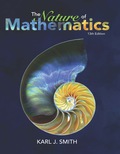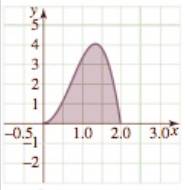
EBK NATURE OF MATHEMATICS
13th Edition
ISBN: 9781305855588
Author: SMITH
Publisher: CENGAGE CO
expand_more
expand_more
format_list_bulleted
Question
Chapter 18.1, Problem 44PS
To determine
To find:
The area of the given figure:

Expert Solution & Answer
Want to see the full answer?
Check out a sample textbook solution
Students have asked these similar questions
Prove it
No chatgpt pls will upvote
During busy political seasons, many opinion polls are conducted. In apresidential race, how do you think the participants in polls are generally selected?Discuss any issues regarding simple random, stratified, systematic, cluster, andconvenience sampling in these polls. What about other types of polls, besides political?
Chapter 18 Solutions
EBK NATURE OF MATHEMATICS
Ch. 18.1 - IN YOUR OWN WORDS What are the three main topics...Ch. 18.1 - Prob. 2PSCh. 18.1 - Prob. 3PSCh. 18.1 - IN YOUR OWN WORDS Zenos paradoxes remind us of an...Ch. 18.1 - Prob. 5PSCh. 18.1 - Consider the sequence 0.4, 0.44, 0.444, 0.4444,,...Ch. 18.1 - Consider the sequence 0.5,0.55,0.555,0.5555,, What...Ch. 18.1 - Consider the sequence 6, 6.6, 6.66, 6.666,, What...Ch. 18.1 - Prob. 9PSCh. 18.1 - Consider the sequence 0.27, 0.2727, 0.272727,,...
Ch. 18.1 - Prob. 11PSCh. 18.1 - Consider the sequence...Ch. 18.1 - Prob. 13PSCh. 18.1 - Prob. 14PSCh. 18.1 - Prob. 15PSCh. 18.1 - Prob. 16PSCh. 18.1 - Prob. 17PSCh. 18.1 - Prob. 18PSCh. 18.1 - Prob. 19PSCh. 18.1 - Prob. 20PSCh. 18.1 - Prob. 21PSCh. 18.1 - Prob. 22PSCh. 18.1 - In Problems 21-38, guess the requested limits....Ch. 18.1 - Prob. 24PSCh. 18.1 - Prob. 25PSCh. 18.1 - Prob. 26PSCh. 18.1 - In Problems 21-38, guess the requested limits....Ch. 18.1 - Prob. 28PSCh. 18.1 - Prob. 29PSCh. 18.1 - Prob. 30PSCh. 18.1 - Prob. 31PSCh. 18.1 - Prob. 32PSCh. 18.1 - Prob. 33PSCh. 18.1 - Prob. 34PSCh. 18.1 - Prob. 35PSCh. 18.1 - Prob. 36PSCh. 18.1 - Prob. 37PSCh. 18.1 - Prob. 38PSCh. 18.1 - Prob. 39PSCh. 18.1 - Prob. 40PSCh. 18.1 - Prob. 41PSCh. 18.1 - Prob. 42PSCh. 18.1 - Prob. 43PSCh. 18.1 - Prob. 44PSCh. 18.1 - Prob. 45PSCh. 18.1 - Prob. 46PSCh. 18.1 - Prob. 47PSCh. 18.1 - Prob. 48PSCh. 18.1 - Prob. 49PSCh. 18.1 - Prob. 50PSCh. 18.1 - Prob. 51PSCh. 18.1 - Prob. 52PSCh. 18.1 - Prob. 53PSCh. 18.1 - Prob. 54PSCh. 18.1 - Prob. 55PSCh. 18.1 - Prob. 56PSCh. 18.1 - Prob. 57PSCh. 18.1 - Prob. 58PSCh. 18.1 - Prob. 59PSCh. 18.1 - Prob. 60PSCh. 18.2 - IN YOUR OWN WORDS What do we mean by the limit of...Ch. 18.2 - Prob. 2PSCh. 18.2 - Prob. 3PSCh. 18.2 - Prob. 4PSCh. 18.2 - Prob. 5PSCh. 18.2 - Prob. 6PSCh. 18.2 - Prob. 7PSCh. 18.2 - Prob. 8PSCh. 18.2 - Prob. 9PSCh. 18.2 - Prob. 10PSCh. 18.2 - Prob. 11PSCh. 18.2 - Prob. 12PSCh. 18.2 - Prob. 13PSCh. 18.2 - Prob. 14PSCh. 18.2 - Prob. 15PSCh. 18.2 - Find each limit in Problems 11-18, if it exists....Ch. 18.2 - Prob. 17PSCh. 18.2 - Prob. 18PSCh. 18.2 - Prob. 19PSCh. 18.2 - Prob. 20PSCh. 18.2 - Prob. 21PSCh. 18.2 - Prob. 22PSCh. 18.2 - Prob. 23PSCh. 18.2 - Prob. 24PSCh. 18.2 - Prob. 25PSCh. 18.2 - Prob. 26PSCh. 18.2 - Prob. 27PSCh. 18.2 - Graph each sequence in the Problems 27-34 in one...Ch. 18.2 - Prob. 29PSCh. 18.2 - Graph each sequence in the Problems 27-34 in one...Ch. 18.2 - Prob. 31PSCh. 18.2 - Prob. 32PSCh. 18.2 - Prob. 33PSCh. 18.2 - Graph each sequence in Problems 27-34 in one...Ch. 18.2 - Prob. 35PSCh. 18.2 - Prob. 36PSCh. 18.2 - Prob. 37PSCh. 18.2 - Prob. 38PSCh. 18.2 - Prob. 39PSCh. 18.2 - Prob. 40PSCh. 18.2 - Prob. 41PSCh. 18.2 - Prob. 42PSCh. 18.2 - Prob. 43PSCh. 18.2 - Prob. 44PSCh. 18.2 - Prob. 45PSCh. 18.2 - Prob. 46PSCh. 18.2 - Find the limit if it exists as n for each of the...Ch. 18.2 - Find the limit if it exists as n for each of the...Ch. 18.2 - Prob. 49PSCh. 18.2 - Find the limit if it exists as n for each of the...Ch. 18.2 - Prob. 51PSCh. 18.2 - Prob. 52PSCh. 18.2 - Prob. 53PSCh. 18.2 - Prob. 54PSCh. 18.2 - Prob. 55PSCh. 18.2 - Prob. 56PSCh. 18.2 - Prob. 57PSCh. 18.2 - Prob. 58PSCh. 18.2 - Prob. 59PSCh. 18.2 - Prob. 60PSCh. 18.3 - Prob. 1PSCh. 18.3 - Prob. 2PSCh. 18.3 - Prob. 3PSCh. 18.3 - Prob. 4PSCh. 18.3 - Prob. 5PSCh. 18.3 - Prob. 6PSCh. 18.3 - Prob. 7PSCh. 18.3 - Prob. 8PSCh. 18.3 - Prob. 9PSCh. 18.3 - Prob. 10PSCh. 18.3 - Prob. 11PSCh. 18.3 - Prob. 12PSCh. 18.3 - Prob. 13PSCh. 18.3 - Prob. 14PSCh. 18.3 - Prob. 15PSCh. 18.3 - Prob. 16PSCh. 18.3 - Prob. 17PSCh. 18.3 - Prob. 18PSCh. 18.3 - Prob. 19PSCh. 18.3 - Prob. 20PSCh. 18.3 - Prob. 21PSCh. 18.3 - Prob. 22PSCh. 18.3 - Prob. 23PSCh. 18.3 - Prob. 24PSCh. 18.3 - Prob. 25PSCh. 18.3 - Prob. 26PSCh. 18.3 - Prob. 27PSCh. 18.3 - Prob. 28PSCh. 18.3 - Prob. 29PSCh. 18.3 - Prob. 30PSCh. 18.3 - Prob. 31PSCh. 18.3 - Prob. 32PSCh. 18.3 - Prob. 33PSCh. 18.3 - Prob. 34PSCh. 18.3 - Prob. 35PSCh. 18.3 - Prob. 36PSCh. 18.3 - Prob. 37PSCh. 18.3 - Prob. 38PSCh. 18.3 - Prob. 39PSCh. 18.3 - Prob. 40PSCh. 18.3 - Prob. 41PSCh. 18.3 - Prob. 42PSCh. 18.3 - Prob. 43PSCh. 18.3 - Prob. 44PSCh. 18.3 - Prob. 45PSCh. 18.3 - Prob. 46PSCh. 18.3 - Prob. 47PSCh. 18.3 - Prob. 48PSCh. 18.3 - Prob. 49PSCh. 18.3 - Prob. 50PSCh. 18.3 - Prob. 51PSCh. 18.3 - Prob. 52PSCh. 18.3 - Prob. 53PSCh. 18.3 - Prob. 54PSCh. 18.3 - Prob. 55PSCh. 18.3 - Prob. 56PSCh. 18.3 - Prob. 57PSCh. 18.3 - Prob. 58PSCh. 18.3 - Prob. 59PSCh. 18.3 - Prob. 60PSCh. 18.4 - Prob. 1PSCh. 18.4 - Prob. 2PSCh. 18.4 - Prob. 3PSCh. 18.4 - Prob. 4PSCh. 18.4 - Prob. 5PSCh. 18.4 - Prob. 6PSCh. 18.4 - Prob. 7PSCh. 18.4 - Prob. 8PSCh. 18.4 - Prob. 9PSCh. 18.4 - Prob. 10PSCh. 18.4 - Prob. 11PSCh. 18.4 - Prob. 12PSCh. 18.4 - Prob. 13PSCh. 18.4 - Prob. 14PSCh. 18.4 - Prob. 15PSCh. 18.4 - Prob. 16PSCh. 18.4 - Prob. 17PSCh. 18.4 - Prob. 18PSCh. 18.4 - Prob. 19PSCh. 18.4 - Prob. 20PSCh. 18.4 - Prob. 21PSCh. 18.4 - Prob. 22PSCh. 18.4 - Prob. 23PSCh. 18.4 - Prob. 24PSCh. 18.4 - Prob. 25PSCh. 18.4 - Prob. 26PSCh. 18.4 - Prob. 27PSCh. 18.4 - Prob. 28PSCh. 18.4 - Prob. 29PSCh. 18.4 - Prob. 30PSCh. 18.4 - Prob. 31PSCh. 18.4 - Prob. 32PSCh. 18.4 - Prob. 33PSCh. 18.4 - Prob. 34PSCh. 18.4 - Prob. 35PSCh. 18.4 - Prob. 36PSCh. 18.4 - Prob. 37PSCh. 18.4 - Prob. 38PSCh. 18.4 - Prob. 39PSCh. 18.4 - Prob. 40PSCh. 18.4 - Prob. 41PSCh. 18.4 - Prob. 42PSCh. 18.4 - Prob. 43PSCh. 18.4 - Prob. 44PSCh. 18.4 - Prob. 45PSCh. 18.4 - Prob. 46PSCh. 18.4 - Prob. 47PSCh. 18.4 - Prob. 48PSCh. 18.4 - Prob. 49PSCh. 18.4 - Prob. 50PSCh. 18.4 - Prob. 51PSCh. 18.4 - Prob. 52PSCh. 18.4 - Prob. 53PSCh. 18.4 - Prob. 54PSCh. 18.4 - Prob. 55PSCh. 18.4 - Prob. 56PSCh. 18.4 - Prob. 57PSCh. 18.4 - Prob. 58PSCh. 18.4 - Prob. 59PSCh. 18.4 - Prob. 60PSCh. 18.CR - Prob. 1CRCh. 18.CR - Prob. 2CRCh. 18.CR - Prob. 3CRCh. 18.CR - Prob. 4CRCh. 18.CR - Prob. 5CRCh. 18.CR - Prob. 6CRCh. 18.CR - Prob. 7CRCh. 18.CR - Prob. 8CRCh. 18.CR - Prob. 9CRCh. 18.CR - Prob. 10CRCh. 18.CR - Prob. 11CRCh. 18.CR - Prob. 12CRCh. 18.CR - Prob. 13CRCh. 18.CR - Prob. 14CRCh. 18.CR - Prob. 15CRCh. 18.CR - Prob. 16CRCh. 18.CR - Prob. 17CRCh. 18.CR - Prob. 18CRCh. 18.CR - Prob. 19CRCh. 18.CR - Prob. 20CR
Knowledge Booster
Learn more about
Need a deep-dive on the concept behind this application? Look no further. Learn more about this topic, subject and related others by exploring similar questions and additional content below.Similar questions
- No chatgpt pls will upvotearrow_forwardWhich degenerate conic is formed when a double cone is sliced through the apex by a plane parallel to the slant edge of the cone?arrow_forwardFor the problem below, what are the possible solutions for x? Select all that apply. 2 x²+8x +11 = 0 x2+8x+16 = (x+4)² = 5 1116arrow_forward
- For the problem below, what are the possible solutions for x? Select all that apply. x² + 12x - 62 = 0 x² + 12x + 36 = 62 + 36 (x+6)² = 98arrow_forwardSelect the polynomials below that can be solved using Completing the Square as written. 6m² +12m 8 = 0 Oh²-22x 7 x²+4x-10= 0 x² + 11x 11x 4 = 0arrow_forwardProve that the usual toplogy is firast countble or hot and second countble. ①let cofinte toplogy onx show that Sivast countble or hot and second firast. 3) let (x,d) be matricspace show that is first and second countble. 6 Show that Indiscret toplogy is firstand Second op countble or not.arrow_forward
- H.W For any events A and B, show that 1. P(AB)s P(A)≤ P(AUB)≤ P(A) + P(B)arrow_forwarda) Find the scalars p, q, r, s, k1, and k2. b) Is there a different linearly independent eigenvector associated to either k1 or k2? If yes,find it. If no, briefly explain.arrow_forwardPlz no chatgpt answer Plz Will upvotearrow_forward
- 1/ Solve the following: 1 x + X + cos(3X) -75 -1 2 2 (5+1) e 5² + 5 + 1 3 L -1 1 5² (5²+1) 1 5(5-5)arrow_forwardI need expert handwritten solution.to this integralarrow_forwardHow to understand and learn Laurent's serial and what's the point of Laurent's serial And what are the steps of a smooth solution for Laurentarrow_forward
arrow_back_ios
SEE MORE QUESTIONS
arrow_forward_ios
Recommended textbooks for you
 Linear Algebra: A Modern IntroductionAlgebraISBN:9781285463247Author:David PoolePublisher:Cengage Learning
Linear Algebra: A Modern IntroductionAlgebraISBN:9781285463247Author:David PoolePublisher:Cengage Learning Trigonometry (MindTap Course List)TrigonometryISBN:9781305652224Author:Charles P. McKeague, Mark D. TurnerPublisher:Cengage Learning
Trigonometry (MindTap Course List)TrigonometryISBN:9781305652224Author:Charles P. McKeague, Mark D. TurnerPublisher:Cengage Learning

Linear Algebra: A Modern Introduction
Algebra
ISBN:9781285463247
Author:David Poole
Publisher:Cengage Learning

Trigonometry (MindTap Course List)
Trigonometry
ISBN:9781305652224
Author:Charles P. McKeague, Mark D. Turner
Publisher:Cengage Learning
An Introduction to Area | Teaching Maths | EasyTeaching; Author: EasyTeaching;https://www.youtube.com/watch?v=_uKKl8R1xBM;License: Standard YouTube License, CC-BY
Area of a Rectangle, Triangle, Circle & Sector, Trapezoid, Square, Parallelogram, Rhombus, Geometry; Author: The Organic Chemistry Tutor;https://www.youtube.com/watch?v=JnLDmw3bbuw;License: Standard YouTube License, CC-BY